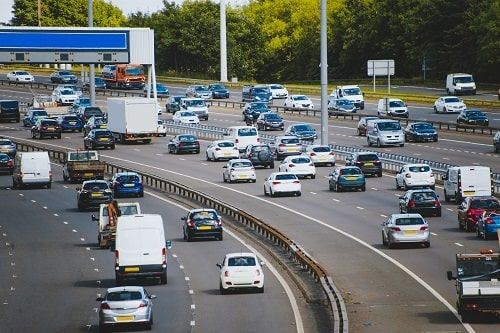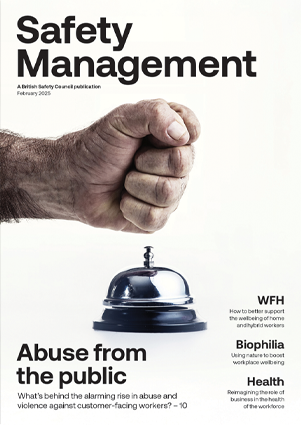Nineteen per cent of workplace fatalities occur from being struck by a moving vehicle, which is an average of 26 fatal injuries per year, according to the Health and Safety Executive’s (HSE) annual statistics report for 2019/20.
Features
Managing road risk: the growing role of technology
In 2019, the European Transport Safety Council reported 51 road deaths per million inhabitants in the European Union (EU). Fortunately, there had been a three per cent decrease in the number of road deaths in the EU during 2018-2019.
 Emma Evans, Senior associate at Pinsent Masons
Emma Evans, Senior associate at Pinsent Masons
A total of 1,752 people were killed in reported road traffic accidents in Great Britain in 2019, similar to the level seen since 2012, which followed a period of substantial reduction in fatalities from 2006 to 2010.
The trend in the number of fatalities has been broadly flat since 2010. In 2019, government figures for road casualties showed there were almost 40,000 deaths and injuries together that involved someone driving for work.
Despite longer-term reductions in the numbers of workers seriously injured or killed each year, the fatal accident profile involving vehicles remains similar year-on-year. UN Global Road Safety Week on 17-23 May 2021 serves as a timely reminder to consider how innovation is being used to help drive forward safety standards, while we also consider any wider practical or legal implications.
Legal framework
The Health and Safety at Work Act 1974 (HSWA) requires employers and the self-employed to ensure, so far as is reasonably practicable, the health, safety and welfare of all employees, while they are at work. In addition, employers have a responsibility to ensure that others – such as members of the public, visitors, contractors etc. – are not put at risk by the work activities of their employees.
 A total of 1,752 people were killed in reported road traffic accidents in Great Britain in 2019, similar to the level seen since 2012. Photograph: iStock
A total of 1,752 people were killed in reported road traffic accidents in Great Britain in 2019, similar to the level seen since 2012. Photograph: iStock
The Management of Health and Safety at Work Regulations 1999 (MHSWR) also require every employer to carry out a suitable and sufficient assessment of any material risk arising from their operations and work activities. Where an employer implements measures to eliminate or reduce risk as low as reasonably practicable, they must do so on the basis of the general principles of prevention. Those principles recognise that ‘technology’ should form part of any coherent prevention policy, thereby acknowledging it can play a vital part in managing risk.
How does health and safety law apply to ‘driving at work’?
The HSWA and MHSWR apply in the context of driving at work, whether using a company or hire vehicle, or indeed an employee’s own vehicle used for business (known as the ‘grey fleet’). Driving can be inherently risky, and not all risk will be removed. However, if the risks arise out of or in connection with the work activities, it is the responsibility of the employer to control them so far as reasonably practicable.
Therefore, managing risks to employees who drive at, and for, work requires more than just drivers’ compliance with relevant road traffic legislation. Managing work-related road risk captures a variety of areas, for example:
- Assessments of drivers’ competence
- Provision of adequate information, instruction and training
- Driver and vehicle licensing checks – ensuring which type of vehicles your driver is legally entitled to drive, and that there is nothing preventing them from doing so with the DVLA (Driver and Vehicle Licensing Agency)
- Ensuring suitable and sufficient risk assessments and arrangements are in place – for driving at work generally, vehicle maintenance and inspection, fatigue, mobile phone usage, drugs and alcohol misuse, work scheduling, loading and unloading and medical fitness etc.
Tech and innovation
Today’s market is awash with technology and artificial intelligence (AI) intended to partially help employers discharge their legal duties; help to monitor safety-related events; or drive behaviours, support learning and ensure safety improvements. For example, telematics, drowsiness and distraction systems, and collision warning systems help employers monitor safety-related events or driver behaviours.
 The new ‘future world of work’ is only likely to see more vehicles on the roads, at least for the short term. Photograph: iStock
The new ‘future world of work’ is only likely to see more vehicles on the roads, at least for the short term. Photograph: iStock
HSE’s Foresight Report in 2018, acknowledged: “AI technologies are being developed to work in a more human-like way including: learning, problem-solving and planning” around risk (see bit.ly/3ajyiJy).
One such example is a company called Applied Driving Techniques, which recently launched a product, ‘Applied Companion’, that it describes as a ‘Fitbit’ for drivers. It is an AI-powered, multi-language smartphone app providing various features, alerts, interventions and training prompts, either sent direct to the driver, or to the employer, or both.
Manufacturers also continue to work with the UK government to introduce in-car, autonomous vehicles (AV) and unmanned technology onto UK roads in the future, subject to further changes in infrastructure, insurance and the regulatory framework. However, Tesla’s Autopilot crash in 2018 – when an employee died after his semi-autonomous driving car hit a concrete barrier, with investigators believing he was playing a video game at the wheel – highlights how further consideration is needed before full implementation of AV.
Enforcement: are we seeing any change?
Failure to comply with the law can have substantial financial, reputational and regulatory consequences, not to mention severely affecting ‘business as usual’ and continued operations. Criminal health and safety prosecutions can attract unlimited fines (as a measure of the company’s revenue/turnover), which are uninsurable and directly impact the defendant company’s profits.
Historically, duty holders may have held the view that regulators didn’t have the appetite to investigate (or certainly enforce) on work-related road risk, particularly when a driver’s personal actions are often considered.
The recent prosecution of Renown Consultants Limited (Renown) in 2020, however, demonstrates regulators are increasingly examining employers’ welfare and work-related road risk policies. This was the first time a UK regulator, the Office of Rail and Road (ORR), prosecuted a company in relation to failures of fatigue management.
The ORR found systemic failures to manage fatigue, non-compliance with insurance policies, non-compliance with working time limits for safety-critical work, and a failure to implement a suitable and sufficient risk assessment. Renown’s failure to enforce its own policies and demonstrate compliance resulted in a criminal conviction and fine of £450,000 (not covered by insurance) and £300,000 in costs.
The road ahead
In conclusion, the spotlight is back on the management of work-related road risk. HSE and the Department for Transport (DfT) are currently seeking to update their existing joint guidance document, Driving at Work (INDG382), to include reference to vehicle safety technologies.
The formal consultation has closed, but focused on: establishing what distractions drivers encounter; what guidance could address those areas, and what barriers exist to managing work-related road risk.
HSE and DfT also recently commissioned TRL (a wholly owned subsidiary of the Transport Research Foundation), to explore the potential safety benefits of safety technologies in vehicles.
Their published report provides recommendations on how the INDG382 guidance could be updated, and factors organisations may wish to consider when implementing vehicle safety monitoring technologies.
The pandemic has seen various industries and their drivers hailed as ‘key workers’, helping to keep the economy moving. The new ‘future world of work’ is only likely to see more vehicles on the roads, at least for the short term. AI and innovation certainly play a role in helping to reduce, and/or monitor work-related road risk. However, some legal and practical considerations can still arise, namely:
- Evaluate and review your arrangements regularly in light of any data (collective or individual) at suitable intervals – turning a blind eye to data which evidences systemic failures or any ongoing non-compliance may not provide a defence in law and should not be ignored
- Ensure that you have up-to-date GDPR and privacy policies, and arrangements to handle and process certain data
- Identify who is responsible for managing work-related road risk and make sure that they know about it – HR, health and safety, compliance, claims, insurance, transport or fleet, or a combination. Do they know it is their responsibility, for example, to consider or review any data being produced?
- Embed a strong safety culture in regards to managing work-related road risk – as with any other health and safety risk – as technology and data do not replace this
- Monitor ongoing performance – continue to consider and review the impact of your AI and innovation in terms of reducing numbers of work-related road risk incidents, the cost of any associated claims, or other linked financial outlays (premium renewals, vehicle repair and maintenance etc.) year-on-year, and
- Consider whether a legal health check, stress test or audit of your work-related road risk policies may help assess whether your control measures (such as training, supervision, information, and/or tech and innovation), stand up to scrutiny, and comply with the latest guidance and best practice.
HSE/DfT Driving at work guidance is at:
hse.gov.uk/pubns/indg382.htm
More on UN Global Road Safety Week at:
unroadsafetyweek.org/en/home
Emma Evans is Senior associate at Pinsent Masons
FEATURES

How Building Information Modelling can improve the management and delivery of occupational safety and health
By Manuel Tender, Digital4OSH on 07 February 2025
Building Information Modelling has traditionally been used to develop and share digital information, plans and 3D models for the efficient design and construction of buildings and other physical assets, but it also holds huge promise for ensuring the safety of construction projects, from the design phase through to the management of the build itself.

Adaptability, ergonomics and wellbeing: building blocks for the workplace in 2025
By Guy Osmond, Osmond Ergonomics and Alex Reffell, Osmond Inclusive Wellbeing Services on 04 February 2025
Employee expectations around the nature and organisation of office, home and hybrid working have changed significantly in recent years, making it more important than ever for employers to rethink and update their approaches to flexible working, ergonomics and workplace design, to better support employee wellbeing, motivation and job satisfaction.

Supporting wellbeing across the flexible extended workplace: why we need a different approach
By Andy Lake, Flexibility.co.uk on 04 February 2025
Flexible working has been shown to offer numerous benefits, from improved employee wellbeing to greater productivity. But the rapidly changing nature of work in a digital age means employers need to take a strategic, joined-up approach when implementing flexible working practices, if they are to fully realise the benefits.



